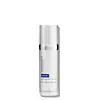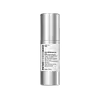What's inside
What's inside
 Key Ingredients
Key Ingredients

 Benefits
Benefits

 Concerns
Concerns

 Ingredients Side-by-side
Ingredients Side-by-side

Water
Skin ConditioningDimethicone
EmollientCyclopentasiloxane
EmollientPolysilicone-11
Acetyl Glucosamine
Skin ConditioningGlycerin
HumectantCyclohexasiloxane
EmollientNylon-12
Silica
AbrasiveOctyldodecyl Stearate
EmollientTocopheryl Acetate
AntioxidantPalmitoyl Tripeptide-1
Skin ConditioningPalmitoyl Tetrapeptide-7
Skin ConditioningSodium Hyaluronate
HumectantCaffeine
Skin ConditioningMalus Domestica Fruit Cell Culture Extract
Skin ConditioningButylene Glycol
HumectantLecithin
EmollientIsohexadecane
EmollientPEG-10 Dimethicone
Skin ConditioningCaprylyl Glycol
EmollientPolysorbate 40
EmulsifyingSorbitan Isostearate
EmulsifyingPolysorbate 60
EmulsifyingCitric Acid
BufferingHydroxyethyl Acrylate/Sodium Acryloyldimethyl Taurate Copolymer
Emulsion StabilisingCarbomer
Emulsion StabilisingPolysorbate 20
EmulsifyingIsostearic Acid
CleansingAmmonium Polyacryloyldimethyl Taurate
Emulsion StabilisingXanthan Gum
EmulsifyingChlorphenesin
AntimicrobialPhenoxyethanol
PreservativeCaramel
Cosmetic ColorantCI 19140
Cosmetic ColorantWater, Dimethicone, Cyclopentasiloxane, Polysilicone-11, Acetyl Glucosamine, Glycerin, Cyclohexasiloxane, Nylon-12, Silica, Octyldodecyl Stearate, Tocopheryl Acetate, Palmitoyl Tripeptide-1, Palmitoyl Tetrapeptide-7, Sodium Hyaluronate, Caffeine, Malus Domestica Fruit Cell Culture Extract, Butylene Glycol, Lecithin, Isohexadecane, PEG-10 Dimethicone, Caprylyl Glycol, Polysorbate 40, Sorbitan Isostearate, Polysorbate 60, Citric Acid, Hydroxyethyl Acrylate/Sodium Acryloyldimethyl Taurate Copolymer, Carbomer, Polysorbate 20, Isostearic Acid, Ammonium Polyacryloyldimethyl Taurate, Xanthan Gum, Chlorphenesin, Phenoxyethanol, Caramel, CI 19140
Water
Skin ConditioningGlycerin
HumectantBoron Nitride
AbsorbentCyclomethicone
EmollientPolysorbate 20
EmulsifyingC12-15 Alkyl Benzoate
AntimicrobialCyclopentasiloxane
EmollientPrunus Amygdalus Dulcis Oil
Skin ConditioningDipeptide Diaminobutyroyl Benzylamide Diacetate
Skin ConditioningAcetyl Octapeptide-3
HumectantAcetyl Hexapeptide-8
HumectantPalmitoyl Oligopeptide
CleansingPalmitoyl Tetrapeptide-7
Skin ConditioningPalmitoyl Tripeptide-5
Skin ConditioningTocopheryl Acetate
AntioxidantRetinyl Palmitate
Skin ConditioningSodium Hyaluronate
HumectantAloe Barbadensis Leaf Juice
Skin ConditioningAllantoin
Skin ConditioningBHT
AntioxidantPrunus Amygdalus Dulcis Seed Extract
Skin ConditioningHelianthus Annuus Seed Oil
EmollientEthylhexylglycerin
Skin ConditioningHexylene Glycol
EmulsifyingPropylene Glycol
HumectantPEG-12 Dimethicone
Skin ConditioningMethyl Gluceth-20
HumectantCarbomer
Emulsion StabilisingDimethicone
EmollientDisodium EDTA
Sodium Hydroxide
BufferingSilica Dimethyl Silylate
EmollientButylene Glycol
HumectantTriethanolamine
BufferingPotassium Sorbate
PreservativeCaprylyl Glycol
EmollientSodium Benzoate
MaskingPhenoxyethanol
PreservativeWater, Glycerin, Boron Nitride, Cyclomethicone, Polysorbate 20, C12-15 Alkyl Benzoate, Cyclopentasiloxane, Prunus Amygdalus Dulcis Oil, Dipeptide Diaminobutyroyl Benzylamide Diacetate, Acetyl Octapeptide-3, Acetyl Hexapeptide-8, Palmitoyl Oligopeptide, Palmitoyl Tetrapeptide-7, Palmitoyl Tripeptide-5, Tocopheryl Acetate, Retinyl Palmitate, Sodium Hyaluronate, Aloe Barbadensis Leaf Juice, Allantoin, BHT, Prunus Amygdalus Dulcis Seed Extract, Helianthus Annuus Seed Oil, Ethylhexylglycerin, Hexylene Glycol, Propylene Glycol, PEG-12 Dimethicone, Methyl Gluceth-20, Carbomer, Dimethicone, Disodium EDTA, Sodium Hydroxide, Silica Dimethyl Silylate, Butylene Glycol, Triethanolamine, Potassium Sorbate, Caprylyl Glycol, Sodium Benzoate, Phenoxyethanol
Ingredients Explained
These ingredients are found in both products.
Ingredients higher up in an ingredient list are typically present in a larger amount.
Butylene Glycol (or BG) is used within cosmetic products for a few different reasons:
Overall, Butylene Glycol is a safe and well-rounded ingredient that works well with other ingredients.
Though this ingredient works well with most skin types, some people with sensitive skin may experience a reaction such as allergic rashes, closed comedones, or itchiness.
Learn more about Butylene GlycolCaprylyl Glycol is a humectant and emollient, meaning it attracts and preserves moisture.
It is a common ingredient in many products, especially those designed to hydrate skin. The primary benefits are retaining moisture, skin softening, and promoting a healthy skin barrier.
Though Caprylyl Glycol is an alcohol derived from fatty acids, it is not the kind that can dry out skin.
This ingredient is also used as a preservative to extend the life of products. It has slight antimicrobial properties.
Learn more about Caprylyl GlycolCarbomer is a polymer of acrylic acid. Its main role is to create a gel consistency.
A high amount of carbomer can cause pilling or balling up of products. Don't worry, most products contain 1% or less of carbomer.
Cyclopentasiloxane, or D5, is a silicone used to improve texture of products and trap moisture.
D5 is considered lightweight and volatile. Volatile means it evaporates quickly after application. Once evaporated, D5 leaves a thin barrier that helps keep skin hydrated.
It is also an emollient. Emollients help soften the skin and prevent water loss. Silicones create a silky texture in products. D5 helps other ingredients become more spreadable.
Studies show D5 is safe to use in skincare products. We recommend speaking with a skincare professional if you have concerns.
Learn more about CyclopentasiloxaneDimethicone is a type of synthetic silicone created from natural materials such as quartz.
What it does:
Dimethicone comes in different viscosities:
Depending on the viscosity, dimethicone has different properties.
Ingredients lists don't always show which type is used, so we recommend reaching out to the brand if you have questions about the viscosity.
This ingredient is unlikely to cause irritation because it does not get absorbed into skin. However, people with silicone allergies should be careful about using this ingredient.
Note: Dimethicone may contribute to pilling. This is because it is not oil or water soluble, so pilling may occur when layered with products. When mixed with heavy oils in a formula, the outcome is also quite greasy.
Learn more about DimethiconeGlycerin is already naturally found in your skin. It helps moisturize and protect your skin.
A study from 2016 found glycerin to be more effective as a humectant than AHAs and hyaluronic acid.
As a humectant, it helps the skin stay hydrated by pulling moisture to your skin. The low molecular weight of glycerin allows it to pull moisture into the deeper layers of your skin.
Hydrated skin improves your skin barrier; Your skin barrier helps protect against irritants and bacteria.
Glycerin has also been found to have antimicrobial and antiviral properties. Due to these properties, glycerin is often used in wound and burn treatments.
In cosmetics, glycerin is usually derived from plants such as soybean or palm. However, it can also be sourced from animals, such as tallow or animal fat.
This ingredient is organic, colorless, odorless, and non-toxic.
Glycerin is the name for this ingredient in American English. British English uses Glycerol/Glycerine.
Learn more about GlycerinPalmitoyl Tetrapeptide-7 (formerly Palmitoyl Tetrapeptide-3) is a lab-made peptide with anti-inflammatory and skin-repairing benefits. It's made up of four amino acids (glycine, glutamine, proline, and arginine) and palmitic acid (which helps it penetrate skin more effectively).
This ingredient helps reduce inflammation by limiting the production of interleukin-6 (IL-6), a chemical that triggers inflammatory responses, particularly after UV exposure.
Less inflammation = slower collagen breakdown and a longer-lasting, youthful appearance.
Palmitoyl Tetrapeptide-7 also stimulates collagen production and supports a healthier skin barrier.
Over time, this can improve skin firmness, hydration, and reduce the appearance of fine lines. It’s commonly paired with Palmitoyl Tripeptide-1 in the well-known Matrixyl 3000 complex for enhanced anti-aging effects.
This ingredient has been shown to be effective and safe in cosmetic use and you'll typically find it in small amounts (less than 0.01%).
Due to its palmitic acid base, it may not be safe for Malassezia folliculitis.
Read more about other common types of peptides here:
Learn more about Palmitoyl Tetrapeptide-7Phenoxyethanol is a preservative that has germicide, antimicrobial, and aromatic properties. Studies show that phenoxyethanol can prevent microbial growth. By itself, it has a scent that is similar to that of a rose.
It's often used in formulations along with Caprylyl Glycol to preserve the shelf life of products.
Polysorbate 20 is made by combining ethoxylation of sorbitan, ethylene oxide, and lauric acid. It is a mild cleansing agent, surfactant, and emulsifier.
As a surfactant, it helps collect dirt and oils for washing. Emulsifiers prevent oils and water from separating.
Polysorbate 20 also adds scent to a product. Since it is made using sorbitol, it has a sweet scent. Sorbitol can also be found in fruits such as apples and peaches.
The lauric acid used to create Polysorbate 20 is often derived from coconuts.
Polysorbate 20 may not be fungal acne safe.
Learn more about Polysorbate 20Sodium Hyaluronate is hyaluronic acid's salt form. It is commonly derived from the sodium salt of hyaluronic acid.
Like hyaluronic acid, it is great at holding water and acts as a humectant. This makes it a great skin hydrating ingredient.
Sodium Hyaluronate is naturally occurring in our bodies and is mostly found in eye fluid and joints.
These are some other common types of Hyaluronic Acid:
Learn more about Sodium HyaluronateTocopheryl Acetate is AKA Vitamin E. It is an antioxidant and protects your skin from free radicals. Free radicals damage the skin by breaking down collagen.
One study found using Tocopheryl Acetate with Vitamin C decreased the number of sunburned cells.
Tocopheryl Acetate is commonly found in both skincare and dietary supplements.
Learn more about Tocopheryl AcetateWater. It's the most common cosmetic ingredient of all. You'll usually see it at the top of ingredient lists, meaning that it makes up the largest part of the product.
So why is it so popular? Water most often acts as a solvent - this means that it helps dissolve other ingredients into the formulation.
You'll also recognize water as that liquid we all need to stay alive. If you see this, drink a glass of water. Stay hydrated!
Learn more about Water